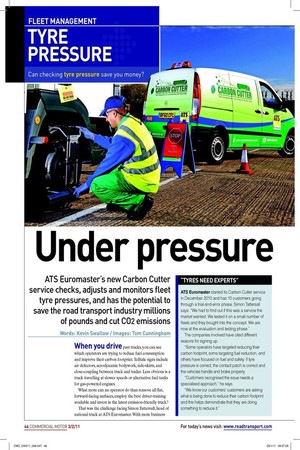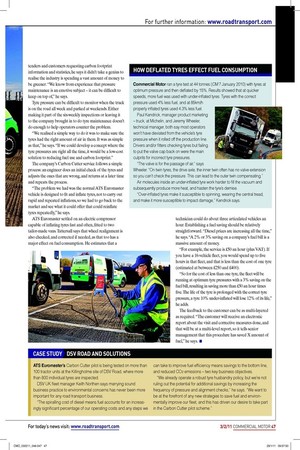Under pressure
Page 40

Page 41

If you've noticed an error in this article please click here to report it so we can fix it.
ATS Euromaster’s new Carbon Cutter service checks, adjusts and monitors fleet tyre pressures, and has the potential to save the road transport industry millions of pounds and cut CO2 emissions
Words: Kevin Swallow / Images: Tom Cunningham
When you drive past trucks, you can see which operators are trying to reduce fuel consumption and improve their carbon footprint. Telltale signs include air defectors, aerodynamic bodywork, side-skirts, and close-coupling between truck and trailer. Less obvious is a truck travelling at slower speeds or alternative fuel tanks for gas-powered engines.
What more can an operator do than remove all lat, forward-facing surfaces, employ the best driver-training available and invest in the latest emission-friendly truck?
That was the challenge facing Simon Tattersall, head of national truck at ATS Euromaster. With more business tenders and customers requesting carbon footprint information and statistics, he says it didn’t take a genius to realise the industry is spending a vast amount of money to be greener. “We know from experience that pressure maintenance is an emotive subject – it can be dificult to keep on top of,” he says.
Tyre pressure can be dificult to monitor when the truck is on the road all week and parked at weekends. Either making it part of the six-weekly inspections or leaving it to the company brought in to do tyre maintenance doesn’t do enough to help operators counter the problem.
“We realised a simple way to do it was to make sure the tyres had the right amount of air in them. It was as simple as that,” he says. “If we could develop a concept where the tyre pressures are right all the time, it would be a low-cost solution to reducing fuel use and carbon footprint.” The company’s Carbon Cutter service follows a simple process: an engineer does an initial check of the tyres and adjusts the ones that are wrong, and returns at a later time and repeats the process.
“The problem we had was the normal ATS Euromaster vehicle is designed to it and inlate tyres, not to carry out rapid and repeated inlations, so we had to go back to the market and see what it could offer that could reinlate tyres repeatedly,” he says.
ATS Euromaster settled on an electric compressor capable of inlating tyres fast and often, itted to two tailor-made vans. Tattersall says that wheel realignment is also checked, and corrected if needed, as that too has a major effect on fuel consumption. He estimates that a technician could do about three articulated vehicles an hour. Establishing a fuel saving should be relatively straightforward. “Diesel prices are increasing all the time,” he says. “A 2% or 3% saving on a company’s fuel bill is a massive amount of money.
“For example, the service is £50 an hour (plus VAT). If you have a 16-vehicle leet, you would spend up to ive hours in that leet, and that is less than the cost of one tyre (estimated at between £250 and £400).
“So for the cost of less than one tyre, the leet will be running at optimum tyre pressures with a 3% saving on the fuel bill, resulting in saving more than £50 an hour times ive. The life of the tyre is prolonged with the correct tyre pressure, a tyre 10% under-inlated will lose 12% of its life,” he adds.
The feedback to the customer can be as multi-layered as required. “The customer will receive an electronic report about the visit and corrective measures done, and that will be at a multi-level report, so it tells senior management that this procedure has saved X amount of fuel,” he says. ■













































